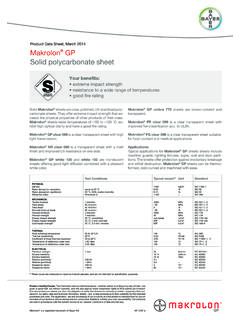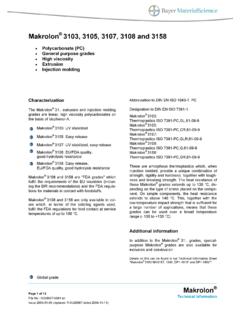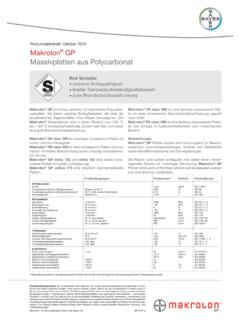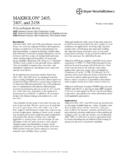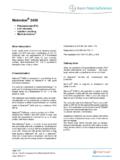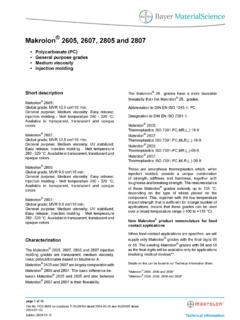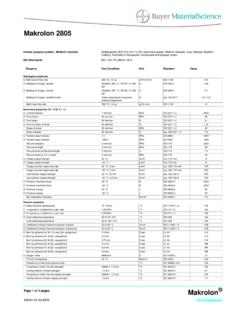Transcription of Makrolon® Cleaning Instructions - afasystemsinc.com
1 makrolon Cleaning Instructions Periodic Cleaning of makrolon polycarbonate, using correct procedures with compatible household cleaners, is recommended to prolong the service life of your material. makrolon GP polycarbonate has a relatively soft surface that mars easily with wiping action. makrolon 15, makrolon AR, and Hygard sheets are hard coated, abrasion/mar resistant polycarbonate products that offer a higher degree of scratch resistance and surface hardness. These products provide superior protection against unintentional chemical attack. However, the use of abrasive, gritty cleaners and/or hard Cleaning implements ( hard brushes, scrapers, squeegees) should be avoided to eliminate the possibility of scratching the surface coating. The following Cleaning techniques are based on standard industry practices. General Cleaning : 1) Thoroughly pre-rinse with warm water to loosen and wash away surface material, grit and grime. 2) Using a soft microfiber cloth or moist non-abrasive sponge, gently wash with a mild diluted soap or detergent.
2 3) Rinse thoroughly with lukewarm clean water. To prevent water spots, thoroughly dry the glazing with a dry soft cloth. Removing Heavy Oils and Tars: 1) Thoroughly pre-rinse with warm water to loosen and wash away surface material, grit and grime. 2) With a 50/50 isopropyl alcohol-water mixture, gently rub the area with a soft non-abrasive cloth. 3) Immediately rinse thoroughly with lukewarm clean water. To prevent water spots, thoroughly dry the glazing with a dry soft cloth. Removing Graffiti, Paint, Marker, Inks and Glazing Compounds: 1) Thoroughly pre-rinse with warm water to loosen and wash away surface material, grit and grime. 2) Using Naphtha VM&P grade, Isopropyl Alcohol or Butyl Cellosolve, gently rub the area with a soft non-abrasive cloth. Do not apply solvent cleaners under direct sunlight or during high temperatures. 3) Immediately rinse thoroughly with lukewarm clean water. To prevent water spots, thoroughly dry the glazing with a dry soft cloth.
3 Removing Adhesive backed Labels: 1) Isopropyl Alcohol, Naphtha VM&P grade or Kerosene will help lift stickers and adhesives. 2) Immediately rinse thoroughly with lukewarm clean water. To prevent water spots, thoroughly dry the glazing with a dry soft cloth. Compatible Cleaners The following Cleaning agents are compatible with makrolon Polycarbonate Sheet products when used according to the manufacturer's recommendations: Top Job, Joy Palmolive Liquid Windex Ammonia free [Top Job and Joy are registered trademarks of Proctor & Gamble, Palmolive is a registered trademark of Colgate Palmolive, Windex is a registered trademark of Drackett Products Company] Points to Remember Do not use abrasive cleaners. Do not use high alkaline cleaners (high pH or ammoniated). Do not leave cleaners sitting on polycarbonate for periods of time; wash off immediately. Do not apply cleaners under direct sunlight or at elevated temperatures. Do not clean your polycarbonate with any unapproved cleaners.
4 When in doubt, seek guidance. Using scrapers, squeegees, razors or other sharp instruments may permanently scratch your polycarbonate. Always avoid dry rubbing/ Cleaning your polycarbonate, as sand and dust particles clinging to the exterior of the glazing may scratch its surface. An Anti-Static Canned-Air Ionizer can reduce electrostatic charge buildup on polycarbonate, consequently reducing dirt and dust buildup that would hinder Cleaning . Special Note: The edges of your polycarbonate sheet are not protected with an abrasion and chemical resistance hard coating. Do not allow Cleaning solutions and solvents to pool along the edges for any length of time. Always rinse edges thoroughly with generous amounts of lukewarm clean water. Removing scratches from makrolon polycarbonate sheet/window Deep scratches and gouges made by sharp objects such as keys, screwdrivers, and knives cannot be repaired. Fine scratches may be reduced in severity or cosmetically hidden by using a buffing compound such as NOVUS 2 Plastic Fine Scratch Remover, followed by a Cleaning and polishing agent like NOVUS 1.
5 However, for abrasion resistant coated products such as makrolon AR, makrolon 15 and makrolon FC, buffing their abrasion resistant coated surface is not recommended because doing so further damages the coating and these scratched sites worsen the condition. Once removed, the coating cannot be repaired and buffing sites may optically distort the window.

